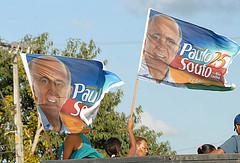 Clinical manifestations As Smeltzer; Bare (2002), the illness of Parkinson presents slow and gradual evolution. The main clinical manifestations of the illness are: unilateral slow tremor; bradicinesia; difficulties to speak; alterations in the movements; rigidity of the neck, trunk and shoulders; increase in the production of saliva with risk for breathlessness and/or aspiration. The unilateral slow tremor can be of rhythmic rest, that disappears with the proposital movement of the member, becoming evident measure that walks or remains motionless more and accented when is concentrated or anxious. According to previous reference the movements of the carriers of the evil of Parkinson can be: slow (bradicinesia); slow abnormal person (hipocinesia);? freezing phenomenon? decurrent of the incapacity to carry through the active movement; they costumam to drag the feet. They present alterations in the position; writing; face expression; in the movements to blink the eyes.
Clinical manifestations As Smeltzer; Bare (2002), the illness of Parkinson presents slow and gradual evolution. The main clinical manifestations of the illness are: unilateral slow tremor; bradicinesia; difficulties to speak; alterations in the movements; rigidity of the neck, trunk and shoulders; increase in the production of saliva with risk for breathlessness and/or aspiration. The unilateral slow tremor can be of rhythmic rest, that disappears with the proposital movement of the member, becoming evident measure that walks or remains motionless more and accented when is concentrated or anxious. According to previous reference the movements of the carriers of the evil of Parkinson can be: slow (bradicinesia); slow abnormal person (hipocinesia);? freezing phenomenon? decurrent of the incapacity to carry through the active movement; they costumam to drag the feet. They present alterations in the position; writing; face expression; in the movements to blink the eyes.
Another characteristic of the pathology is the rigidity of the neck. trunk and shoulders. In the initial period of training it is common algia in the shoulder in virtue of the resistance to the slow and which had movement to the unilateral comprometimento. while the other is active and voluntary. The slowness of the movements, the rigidity and the tremor are the cardeiais signals of the evil of Parkinson, the tremor of the fingers resemble the movement to count money to it, in the advanced periods of training of the illness the carrier can present dementia and lose the autocuidado capacity of, difficulty to carry through activities of the daily life as to take bath, to change of clothes and uprising ( FREITAS, et al, 2002).
 One concluded that although the knowledge told for purperas on basic questions that involve breast-feeding, perceives one deficiency in the spreading of these information to the mothers. The actions are suggested that educative and preventive, are spread out in all the after-Christmas attendance, having emphasized the importance of the aleitamento, the advantages that human milk has on other milk, demonstrating its nutricionais values, detaching despite pain is a common signal of this process, but that writ of prevention they can minimize the problem. PALAVRAS-CHAVE: exclusive maternal aleitamento, assistance of nursing, purperas. INTRODUCTION human milk is the feeding form most economic, and preferred for the neonato the term, is always available, soon to be served to the ambient temperature and exempt of contamination, it offers to protection against the obesidade and aterosclerose. The suckled neonatos, especially beyond two the three months of age, tend to grow in a satisfactory speed, however, slower than the neonatos suckled with baby’s bottles (WHALEY; WONG 1999).
One concluded that although the knowledge told for purperas on basic questions that involve breast-feeding, perceives one deficiency in the spreading of these information to the mothers. The actions are suggested that educative and preventive, are spread out in all the after-Christmas attendance, having emphasized the importance of the aleitamento, the advantages that human milk has on other milk, demonstrating its nutricionais values, detaching despite pain is a common signal of this process, but that writ of prevention they can minimize the problem. PALAVRAS-CHAVE: exclusive maternal aleitamento, assistance of nursing, purperas. INTRODUCTION human milk is the feeding form most economic, and preferred for the neonato the term, is always available, soon to be served to the ambient temperature and exempt of contamination, it offers to protection against the obesidade and aterosclerose. The suckled neonatos, especially beyond two the three months of age, tend to grow in a satisfactory speed, however, slower than the neonatos suckled with baby’s bottles (WHALEY; WONG 1999).